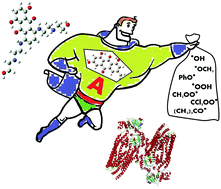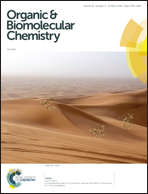Selected anthraquinones as potential free radical scavengers and P-glycoprotein inhibitors†
Abstract
Disruption of homeostasis can increase the amount of free radicals formed during metabolic processes. This phenomenon known as oxidative stress can have numerous negative outcomes. The role of dietary antioxidants is to help the prevention of oxidative stress. We investigated free radical scavenging capacity of six structurally similar anthraquinones (alizarin, purpurin, chrysophanol, emodin, aloe-emodin and 1,3,8-trihydroxyanthraquinone) for inactivating a set of ten hydroxy and peroxy free radicals. The antioxidant capacity of anthraquinones was estimated by considering Gibbs free energy of three studied reaction mechanisms: hydrogen atom transfer (HAT), single-electron transfer followed by proton transfer (SET-PT) and sequential proton loss electron transfer (SPLET). The geometry of all participants in chemical reactions was optimized using the M06-2X/6-311++G(d,p) level of theory. Benzene, pentyl ethanoate, dimethyl sulfoxide and water were used to investigate the impact of solvent polarity on the thermodynamic feasibility of antiradical reactions. It was found that HAT and SPLET mechanisms are operative and competitive, while the SET-PT mechanism is not thermodynamically plausible. Among the studied anthraquinones, AL and PU showed the highest scavenging capacity. Their reactivity toward free radicals decreases as follows:˙OH > (CH3)3C–O˙ ≈ ˙OCH3 > CCl3–O–O˙ > PhO˙ > ˙OOH ≈ CH2![[double bond, length as m-dash]](https://www.rsc.org/images/entities/char_e001.gif) CH–O–O˙ ≈ CH3–O–O˙ ≈ CH2
CH–O–O˙ ≈ CH3–O–O˙ ≈ CH2![[double bond, length as m-dash]](https://www.rsc.org/images/entities/char_e001.gif) CH–CH2–O–O˙ ≫ O2˙−. Inhibition activity of anions of the selected six anthraquinones toward P-glycoproteins was estimated using docking analysis. The obtained results suggest that all the investigated compounds are potential inhibitors of P-glycoproteins under physiological conditions, indicating them as potential protectors against patient resistance toward various anticancer drugs.
CH–CH2–O–O˙ ≫ O2˙−. Inhibition activity of anions of the selected six anthraquinones toward P-glycoproteins was estimated using docking analysis. The obtained results suggest that all the investigated compounds are potential inhibitors of P-glycoproteins under physiological conditions, indicating them as potential protectors against patient resistance toward various anticancer drugs.



 Please wait while we load your content...
Please wait while we load your content...